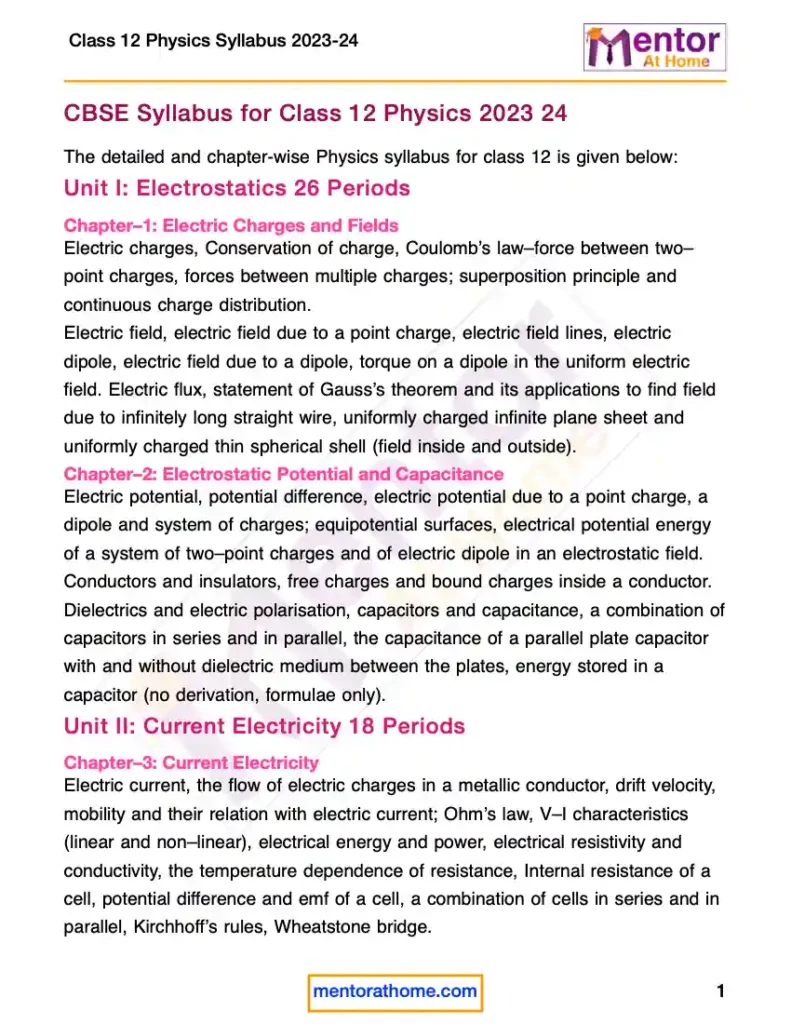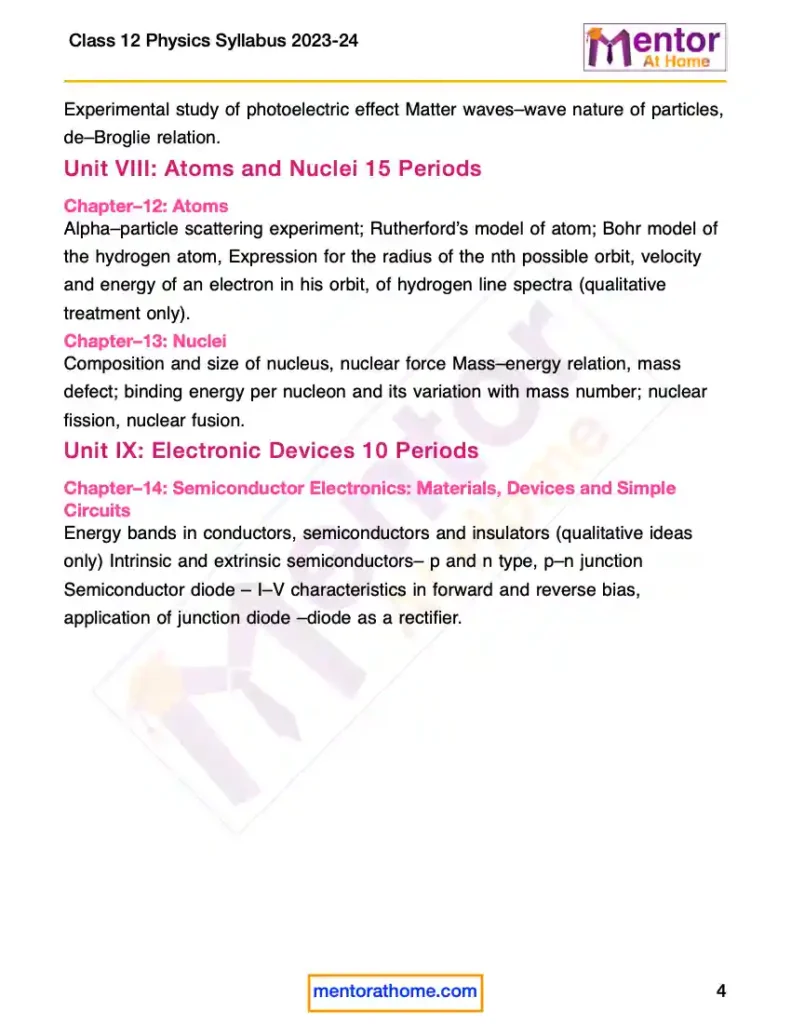CBSE Class 12 Physics Syllabus 2023-24
Here we provide the latest CBSE Class 12 Physics Syllabus 2023-24. You can also Download the new and revised CBSE Physics syllabus class 12 PDF. The present revised CBSE syllabus of class 12 Physics has been designed in accordance with National Curriculum Framework 2005.
Physics is a scoring subject but needs a lot of practice and conceptual understanding of the topics. CBSE Physics syllabus class 12 helps you understand the important topics. We advise you to read the CBSE class 12 Physics syllabus 2023 24 carefully. Class 12th Physics syllabus also helps you in preparation for competitive exams like IIT, AIEEE etc.
You may also like
- Class 12 NCERT Solution
- Class 12 NCERT Books
- Class 12 NCERT Notes
- Class 12 Syllabus for all Subjects
CBSE Class 12 Physics Syllabus 2023-24 Pdf
Click here to download Class 12th Physics Syllabus Pdf
CBSE Syllabus for Class 12 Physics 2023 24
The detailed and chapter-wise Physics syllabus for class 12 is given below:
Unit I: Electrostatics 26 Periods
Chapter–1: Electric Charges and Fields
Electric charges, Conservation of charge, Coulomb’s law–force between two–point charges, forces between multiple charges; superposition principle and continuous charge distribution.
Electric field, electric field due to a point charge, electric field lines, electric dipole, electric field due to a dipole, torque on a dipole in the uniform electric field. Electric flux, statement of Gauss’s theorem and its applications to find field due to infinitely long straight wire, uniformly charged infinite plane sheet and uniformly charged thin spherical shell (field inside and outside).
Chapter–2: Electrostatic Potential and Capacitance
Electric potential, potential difference, electric potential due to a point charge, a dipole and system of charges; equipotential surfaces, electrical potential energy of a system of two–point charges and of electric dipole in an
electrostatic field.
Conductors and insulators, free charges and bound charges inside a conductor. Dielectrics and electric polarization, capacitors and capacitance, a combination of capacitors in series and in parallel, the capacitance of a parallel plate capacitor with and without dielectric medium between the plates, energy stored in a capacitor (no derivation, formulae only).
Unit II: Current Electricity 18 Periods
Chapter–3: Current Electricity
Electric current, the flow of electric charges in a metallic conductor, drift velocity, mobility and their relation with electric current; Ohm’s law, V–I characteristics (linear and non–linear), electrical energy and power, electrical resistivity and conductivity, the temperature dependence of resistance, Internal resistance of a cell, potential difference and emf of a cell, a combination of cells in series and in parallel, Kirchhoff’s rules, Wheatstone bridge.
Unit III: Magnetic Effects of Current and Magnetism 25 Periods
Chapter–4: Moving Charges and Magnetism
Concept of the magnetic field, Oersted’s experiment.
Biot – Savart law and its application to the current carrying circular loop. Ampere’s law and its applications to an infinitely long straight wire. Straight solenoid (only qualitative treatment), force on a moving charge in uniform magnetic and electric fields.
Force on a current–carrying conductor in a uniform magnetic field, the force between two parallel current–carrying conductors–definition of ampere, torque experienced by a current loop in a uniform magnetic field; Current loop as a magnetic dipole and its magnetic dipole moment, moving coil galvanometer– its current sensitivity and conversion to ammeter and voltmeter.
Chapter–5: Magnetism and Matter
Bar magnet, bar magnet as an equivalent solenoid (qualitative treatment only), magnetic field intensity due to a magnetic dipole (bar magnet) along its axis and perpendicular to its axis (qualitative treatment only), torque on a magnetic dipole (bar magnet) in a uniform magnetic field (qualitative treatment only), magnetic field lines.
Magnetic properties of materials– Para–, dia– and ferromagnetic substances with examples, Magnetization of materials, the effect of temperature on magnetic properties.
Unit IV: Electromagnetic Induction and Alternating Currents 24 Periods
Chapter–6: Electromagnetic Induction
Electromagnetic induction; Faraday’s laws, induced EMF and current; Lenz’s Law, Self and mutual induction.
Chapter–7: Alternating Current
Alternating currents, peak and RMS value of alternating current/voltage; reactance and impedance; LCR series circuit (phasors only), resonance, power in AC circuits, power factor, wattless current. AC generator, Transformer.
Unit V: Electromagnetic waves 04 Periods
Chapter–8: Electromagnetic Waves
The basic idea of displacement current, Electromagnetic waves, their characteristics, and their transverse nature (qualitative idea only). Electromagnetic spectrum (radio waves, microwaves, infrared, visible, ultraviolet, X–rays, gamma rays) including elementary facts about their uses.
Unit VI: Optics 30 Periods
Chapter–9: Ray Optics and Optical Instruments
Ray Optics: Reflection of light, spherical mirrors, mirror formula, refraction of light, total internal reflection and optical fibres, refraction at spherical surfaces, lenses, thin lens formula, lens maker’s formula, magnification, power of a lens, combination of thin lenses in contact, refraction of light through a prism.
Optical instruments: Microscopes and astronomical telescopes (reflecting and refracting) and their magnifying powers.
Chapter–10: Wave Optics
Wave optics: Wave front and Huygen’s principle, reflection and refraction of plane wave at a plane surface using wave fronts. Proof of laws of reflection and refraction using Huygen’s principle. Interference, Young’s double slit experiment and expression for fringe width (No derivation final expression only), coherent sources and sustained interference of light, diffraction due to a single slit, and width of central maxima (qualitative treatment only).
Unit VII: Dual Nature of Radiation and Matter 08 Periods
Chapter–11: Dual Nature of Radiation and Matter
Dual nature of radiation, Photoelectric effect, Hertz and Lenard’s observations;
Einstein’s photoelectric equation–particle nature of light.
Experimental study of photoelectric effect Matter waves–wave nature of particles, de–Broglie relation.
Unit VIII: Atoms and Nuclei 15 Periods
Chapter–12: Atoms
Alpha–particle scattering experiment; Rutherford’s model of atom; Bohr model of the hydrogen atom, Expression for the radius of the nth possible orbit, velocity and energy of an electron in his orbit, of hydrogen line spectra (qualitative treatment only).
Chapter–13: Nuclei
Composition and size of nucleus, nuclear force Mass–energy relation, mass defect; binding energy per nucleon and its variation with mass number; nuclear fission, nuclear fusion.
Unit IX: Electronic Devices 10 Periods
Chapter–14: Semiconductor Electronics: Materials, Devices and Simple Circuits
Energy bands in conductors, semiconductors and insulators (qualitative ideas only) Intrinsic and extrinsic semiconductors– p and n type, p–n junction Semiconductor diode – I–V characteristics in forward and reverse bias, application of junction diode –diode as a rectifier.
Class 11 Practicals Total Periods 60
The record to be submitted by the students at the time of their annual examination has to include:
- Record of at least 8 Experiments [with 4 from each section], to be performed by the students.
- Record of at least 6 Activities [with 3 each from section A and section B], to be
performed by the students. - The Report of the project carried out by the students.
Prescribed Books:
1. Physics, Class XI, Part –I and II, Published by NCERT.
2. Physics, Class XII, Part –I and II, Published by NCERT.
3. Laboratory Manual of Physics for class XII Published by NCERT.
4. The list of other related books and manuals brought out by NCERT
(consider multimedia also).
Class 12th Physics Syllabus 2023-24 – Course Structure
Before you read the Class 12th physics syllabus you have to understand the course structure to complete the Physics syllabus for Class 12
| Unit No. | Name of Unit | No. of Periods | Marks |
| Unit–I | Electrostatics | 26 | 16 |
| Chapter–1: Electric Charges and Fields | |||
| Chapter–2: Electrostatic Potential and Capacitance | |||
| Unit-II | Current Electricity | 18 | |
| Chapter–3: Current Electricity | |||
| Unit-III | Magnetic Effects of Current and Magnetism | 25 | 17 |
| Chapter–4: Moving Charges and Magnetism | |||
| Chapter–5: Magnetism and Matter | |||
| Unit-IV | Electromagnetic Induction and Alternating Currents | 24 | |
| Chapter–6: Electromagnetic Induction | |||
| Chapter–7: Alternating Current | |||
| Unit–V | Electromagnetic Waves | 04 | 18 |
| Chapter–8: Electromagnetic Waves | |||
| Unit–VI | Optics | 30 | |
| Chapter–9: Ray Optics and Optical Instruments | |||
| Chapter–10: Wave Optics | |||
| Unit–VII | Dual Nature of Radiation and Matter | 08 | 12 |
| Chapter–11: Dual Nature of Radiation and Matter | |||
| Unit–VIII | Atoms and Nuclei | 15 | |
| Chapter–12: Atoms | |||
| Chapter–13: Nuclei | |||
| Unit–IX | Electronic Devices | 10 | 07 |
| Chapter–14: Semiconductor Electronics: Materials, Devices and Simple Circuits | |||
| Total | 160 | 70 |
class 12 physics chapters
physics chapters class 12
physics class 12 chapters



